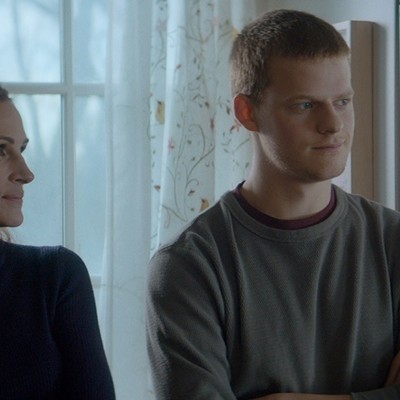Despite its title, Erik Nelson’s doc A Gray State is ultimately quite black and white, a welcome reproach to the American vogue for conspiracy theorizing and true-crime speculating. In January 2015, a Minnesota family was found dead in its home: David Crowley; his wife, Komel; and their 4-year-old daughter. A veteran of our desert wars and an aspiring filmmaker beloved by the most fringy of Libertarians and the Alex Jones set, Crowley had long been working on the script for an independent film called Gray State, a dystopian action thriller about FEMA taking over America.
To drum up interest, Crowley spent several years shooting a sizzle-reel trailer, creating with actors, CGI and green screens scenes of bloody mayhem that would do Hollywood proud. The project became a cause of a sort in those pockets of the internet where dudes worry over the inevitability of the federal government taking up arms against them. Police ruled the deaths a murder-suicide, perpetrated by Crowley himself, a finding that has also become an online cause — especially since the words “Allahu akbar” had been scrawled on the living-room wall in blood. Many fans of the film he was planning to make just don’t buy it.
Nelson’s film is assembled from clips of Crowley’s Gray State work, behind-the-scenes footage of him jollily staging government executions, plus many more intimate sources. We hear excerpts from Crowley’s journals and disturbing messages recorded on his phone, including one from not long before the deaths when Komel, weeping, says that she has been “raptured.” Friends, family and reporters offer invaluable insight in interviews, making this the somewhat rare documentary that’s actually as illuminating as good print reporting on the same case. (Alec Wilkinson published a strong feature in the New Yorker in April, and Cory Zurowski of Minneapolis’ City Pages wrote the definitive piece in the spring of 2016.)
A Gray State doesn’t dwell much on crime-scene evidence or the possible motives of other parties, as so much true-crime documentary entertainment insists upon. A recurring image is of Crowley standing before a string-and-Post-Its wall map of the plot of his movie, a vision right out of American Vandal or any show or film about a dogged hero unraveling a conspiracy. But Nelson resists the temptation to sensationalize or chase down tenuous connections. Instead, his film focuses on Crowley and his family, their states of mind, their increasing isolation from everyone outside. The question, in the end, is not the elaborate “Who?” favored by the amateur investigators working the case online. It’s the simpler but more troubling “Why?”
Support Us
Houston's independent source of
local news and culture
account
- Welcome,
Insider - Login
- My Account
- My Newsletters
- Contribute
- Contact Us
- Sign out
A Gray State Reminds Us That, Seriously, There’s Usually Not a Conspiracy, Guys
Alan Scherstuhl October 31, 2017 8:00PM

In Erik Nelson’s documentary A Gray State, there's a recurring image of David Crowley standing before a string-and-Post-Its wall map of the plot of his movie.
Courtesy of A&E Indie Films and First Run Features
[
{
"name": "Related Stories / Support Us Combo",
"component": "11591218",
"insertPoint": "4",
"requiredCountToDisplay": "4"
},{
"name": "Air - Billboard - Inline Content",
"component": "11591214",
"insertPoint": "2/3",
"requiredCountToDisplay": "7"
},{
"name": "R1 - Beta - Mobile Only",
"component": "12287027",
"insertPoint": "8",
"requiredCountToDisplay": "8"
},{
"name": "Air - MediumRectangle - Inline Content - Mobile Display Size 2",
"component": "11591215",
"insertPoint": "12",
"requiredCountToDisplay": "12"
},{
"name": "Air - MediumRectangle - Inline Content - Mobile Display Size 2",
"component": "11591215",
"insertPoint": "4th",
"startingPoint": "16",
"requiredCountToDisplay": "12"
}
,{
"name": "RevContent - In Article",
"component": "12527128",
"insertPoint": "3/5",
"requiredCountToDisplay": "5"
}
]
KEEP THE HOUSTON PRESS FREE...
Since we started the Houston Press, it has been defined as the free, independent voice of Houston, and we'd like to keep it that way. With local media under siege, it's more important than ever for us to rally support behind funding our local journalism. You can help by participating in our "I Support" program, allowing us to keep offering readers access to our incisive coverage of local news, food and culture with no paywalls.
Alan Scherstuhl is film editor and writer at Voice Media Group. VMG publications include Denver Westword, Miami New Times, Phoenix New Times, Dallas Observer, Houston Press and New Times Broward-Palm Beach.
Contact:
Alan Scherstuhl
Follow:
Twitter:
@studiesincrap
Trending Film
- International Film Festival 2000
- It’s Sadly Kind of Perfect That New Season of GLOW Is Stolen by Marc Maron
- Made in Houston
-
Sponsored Content From: [%sponsoredBy%]
[%title%]

Don't Miss Out
SIGN UP for the latest
news, free stuff and more!
Become a member to support the independent voice of Houston
and help keep the future of the Houston Press FREE
Use of this website constitutes acceptance of our
terms of use,
our cookies policy, and our
privacy policy
The Houston Press may earn a portion of sales from products & services purchased through links on our site from our
affiliate partners.
©2024
Houston Press, LP. All rights reserved.





